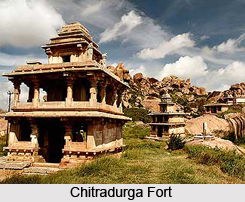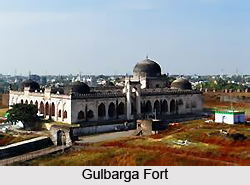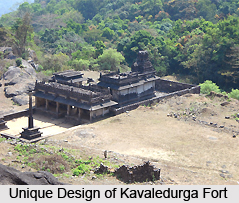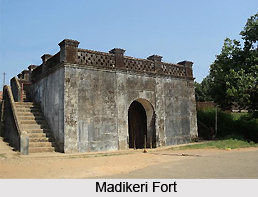 Forts in Karnataka boast of unique architectural marvels and have been integral to the culture practised under the reign of the Nizams. Currently, the forts of Karnataka are significant revenue earners in the field of tourism in the country as they are thronged by innumerable travellers and historians from all across India. These historical structures bear testimony to the stronghold of the regional Sultans who once governed this portion of the nation and had defended their territories from their enemies. The first located in Belgaum and Gadag are amongst the significant local forts.
Forts in Karnataka boast of unique architectural marvels and have been integral to the culture practised under the reign of the Nizams. Currently, the forts of Karnataka are significant revenue earners in the field of tourism in the country as they are thronged by innumerable travellers and historians from all across India. These historical structures bear testimony to the stronghold of the regional Sultans who once governed this portion of the nation and had defended their territories from their enemies. The first located in Belgaum and Gadag are amongst the significant local forts.
Bangalore Fort
Kempe Gowda had established the Bangalore Fort during 1537 which was later transformed into a stone fort in 1761 by Hyder Ali. Presently, visitors will notice only the Delhi Gate of this fort which is based on Krishnarajendra Road which is equipped with a marble plaque. This plaque was created in the memory of the area where a break in the wall had enabled British to capture the fort. Tipu Sultan held this fort.
Bellary Fort
Bellary Fort was erected on the summit of a hill known as the `Ballari Gudda` or the `Fort Hill`. The fort is existent in Bellary city, Bellary District of Karnataka. The Upper Fort and the Lower Fort are the two distinct parts of this fort. Hanumappa Nayaka had created the Upper Fort while the Lower Fort was constructed by Hyder Ali in the latter portion of the 18th century. Numerous sacred and historical structures are located inside the fort which also contains beautiful ramparts.
 Bijapur Fort
Bijapur Fort
Situated in the city of Bijapur in Bijapur District, the Bijapur Fort is a collection of spectacular buildings which boast of architectural grandeur and were erected during the reign of the Adil Shahi Dynasty. Yusuf Adil Shah had built the fort and its citadel in the year 1565. Palaces, tombs, gardens and mosques are all present in the premises of the fort which exhibit Adil Shahi architecture. The Dattatreya Templewhich was erected by Ibrahim II is also existent here.
Chitradurga Fort
One of the most popular forts is the Chitradurga Fort which was constructed in different stages, between the 17th and 18th centuries by the various rulers consisting of the Nayakas of Chitradurga, Rashtrakuta, Hoysalas and the Chalukyas. The fort was previous referred to as `Chitrakaldurga` which also implies spectacular fort according to the Kannada language. The lower fort possesses a large temple while the upper fort comprises as many as 18 temples.
Gulbarga Fort
Gulbarga Fort exists in Gulbarga in Gulbarga District of North Karnataka and was initially constructed by Raja Gulchand during the period of the royal dynasty of Warangal. However, in 1341 the fort was remodified and made much larger by the ruler Al-ud-din Bahmani belonging to the Bahmani Dynasty. The fort was erected in the memory of the establishment of the regime of the Bahmani Dynasty in the period between 1327 and 1424. Jama Masjid was built in the tomb, with the aide of Persian architectural style.
Kavaledurga Fort
Built during the 9th century, Kavaledurga Fort is based at a distance of about 18 kms away from the area of Thirthahalli in Shimoga District. During the 14th century, the fort was remodified by a ruler named Cheluvarangappa. The Kavaledurga Fort is also termed as `Bhuvanagiri Fort` and was occupied by the Nayakas of Keladi, who were feudal lords serving Vijayanagara rulers. However following the downfall of the rulers of Vijayanagara Empire, they asserted their independence. Large granite blocks have been employed to establish the three-lined walls of the fort.
 Madikeri Fort
Madikeri Fort
Mudduraja is said to have created the Madikeri Fort during the later part of the 17th century and he has also erected a palace inside the fort grounds. Tipu Sultan had reconstructed the fort with the aide of granite and renamed it as `Jaffarabad Fort`. The fort was captured by Doddavira Rajendra in 1790. Further modifications to the Madikeri Fort was added by the British during 1834 and Lingarajendra Wodeyar II had remodelled the fort during the period from 1812 and 1814.
Raichur Fort
Raichur Fort has been existent since the era of the Badami Chalukyas and eventually was beautifully renovated during the regime of the Kalyani Chalukyas. The fort was strengthened in 1294 AD by the Kakatiya rulers of Warangal. The northern gateway of Raichur Fort was added by King Krishnadevaraya, the ruler of Vijayanagara Empire. The fort was utilized by the rulers of various dynasties including the Kakatiyas, Bahmanis, Mauryas, Rashtrakutas, Satavahanas, Nizams and others.
Sadashivgad Fort
Sadashivgad Fort is present in the area of Karwar in Uttara Kannada District in Karnataka. Today, visitors will find that the fort lies in complete ruins and yet it is thronged by several tourists. The fort was established at the intersection of Arabian Sea and Kali River`s bridge and it measures 60 metres by 20 metres. Earlier Sadashivgad Fort was a satellite fort defending the north-eastern and eastern portion of the region of Karwar.
Vanadurga Fort
 Rulers of the Shorapur Dynasty had established the Vanadurga Fort in the village of Vanadurga in Shahpur Taluka of Yadgir District. Vanadurga village is located on the northern portion of Shorapur and western part of Shahpur.
Rulers of the Shorapur Dynasty had established the Vanadurga Fort in the village of Vanadurga in Shahpur Taluka of Yadgir District. Vanadurga village is located on the northern portion of Shorapur and western part of Shahpur.
Other Forts of Karnataka
Karnataka is home to numerous other forts including Bahaddur Bandi Fort, Basavakalyana Fort, Bankapura Fort, Bhalki Fort, Channagiri Fort, Devanahalli Fort, Dambal Fort, Gajendragarh Fort, Gudibanda Fort, Hampir Fort, Hemagudda Fort, Irkalgada Fort, Kummata Durga Fort, Koppal Fort, Malkheda Fort, Madhugiri Fort, Mirjan Fort, Pavagad Fort, Sedam Fort, Tippapura Fort, Sanduru Fort and much more.



















